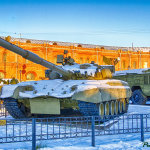On 7 February 1984, Saddam Hussein ordered air and missile attacks against 11 Iranian cities, having previously invaded southern Iran and faced unexpected resistance. It marked the beginning of what became known as ‘the war of the cities’. He little reckoned that they may hit back if you attack somebody else’s cities. Now Putin has joined the list of totalitarian rulers – Saddam Hussein, Hitler and others – who imagined they could bully and cow other countries through bombardments without consequences. This article looks at one aspect of Ukraine’s fight back: the recent drone campaign against western Russian oil refineries.
The record of attacks
Kyiv attempted raids against Russian oil depots in border areas from the beginning of the war. However, it is only recently, with the development and fielding of long-range drones, that Ukraine has been able to mount a concerted campaign against the most vulnerable and valuable targets – oil refineries. The record of attacks from the beginning of the year (including depots and other industrial sites) is shown in the table below. In total, 11 oil refineries1, one gas liquefaction processing plant and one district power plant have been hit.
| Ukrainian drone attacks against western Russian oil facilities January-March 2024 | ||
| Date | Target | Comment |
| 18 Jan | Saint Petersburg Oil Terminal | This is Russia’s largest oil products transhipment terminal in the Baltic region and the largest stevedoring company at the Port of St Petersburg. The range is to target 900km. |
| 25 Jan | Tuapse oil refinery, Black Sea | The vacuum distillation column caught fire following three strikes—range to target 500km. |
| 31 Jan | Nevsky Mazut oil refinery, Baltic Sea port of St Petersburg | Intercept by S-400 was reportedly attempted but failed. Range to target 850km. |
| 3 Feb | Lukoil oil refinery, Volgograd | Two explosions were reported. |
| 9 Feb | Ilsky and Afipsky oil refineries in Krasnodar region | Separately, an oil depot in the Orel region was also hit. A primary processing unit at Ilsky with a capacity of 3.6 million tons per year was damaged. The Afipsky facility’s refining capacity is 6.25 million tons per year. Range to target 500km. |
| 14 Feb | Kursk oil depot | A100-ton fuel tank was hit and set on fire. |
| 6 Mar | Mikhailovsky Mining Plant, Kursk | This is Russia’s second-largest iron ore mining and processing facility. A storage tank was set on fire. |
| 12 Mar | Lukoil-Nizhegorodnefteorgsintez oil refinery at Kstovo, Nizhny Novgorod Oblast. | The Lukoil refinery at Nizhny Novgorod is the most important facility in western Russia. Range to target 800km. The Orelnefteprodukt JSC enterprise in Orel was hit, setting fire to a 150-ton fuel tank. |
| 13 Mar | Rosneft oil refinery in Ryazan | Two primary oil processing units were damaged. They accounted for 70% of the plant’s capacity. |
| 15 Mar | Oil refinery in Kaluga | The Kaluga refinery, located about 65km from Moscow, has a processing capacity of 1.2 million tons per year, or roughly 24,000 barrels per day. The range is to target 300km. |
| 16 Mar | Three oil refineries in Samara region | No further details |
| 17 Mar | Slavyansk oil refinery, Krasnodar Krai. | Telegram video showed an extensive fire. |
| 23 Mar | Novokuibyshevsk oil refinery, Samara Oblast | Locals reported multiple explosions. Telegram video showed extensive fires. The refinery was responsible for 1.34% of Russia’s total oil refining capacity, processing 3.687 million tons of crude oil last year. The refinery halted one of its two primary refining units (CDU-5) representing half of its capacity, or 70,000 bpd. It was subsequently reported all operations were suspended (CDU5 and CDU-4). |
| 24 Mar | Oil depot, Hvardiiske north of Sevastopol, Crimea | The attack was part of a wider, coordinated strike involving as many as 40 drones, ADM-160 decoy missiles, Neptune missiles, and Storm Shadow cruise missiles against a range of targets, including the large amphibious landing ships (BDKs) Yamal and Azov and the Black Sea Fleet communications hub in Sevastopol. |
| 25 Mar | Novocherkassk DRES | Two power units were damaged and stopped. Novocherkassk GRES (State District Power Plant) is the largest thermal power plant in the Rostov Region after the Rostov NPP. |
| 2 Apr | Elaz-Naftoprodukt Tatneft Taneko refinery, Nizhnyokamsk, Tatarstan | The Tatneft Taneko refinery is the fifth largest in Russia. The plant at nearby Yelabuz manufacturing the Russian version of the Iranian Shaheed-136/131 was also attacked. Range to target 1,200km. |
The longest-range attacks have been 1,200 kilometres.2 Russian sources typically report 20-30 drones launched per attack (Ukrainian sources cite a lesser number of 2-6 per target, suggesting Russian radar operators may be over-reporting detections). A majority are downed, but in a mirror of the situation in Ukraine, air defences are unable to down all air targets. The drones will get through if sufficient numbers are launched.

Lyutyi my beauty
Ukrainian enterprises have developed a large number of long-range drones (pictured below). The most successful, and the type used to attack oil refineries, is named Lyutyi (‘Fierce/Furious’ or ‘February’).

Lyutyi was conceived by Ukroboronprom in October 2022. The specification was an attack drone weighing over 200 kg, capable of carrying a 75 kg warhead at a distance of more than 1,000 km. Az Vozdam (Old Slavonic for ‘I will repay’, referring to Romans 12:19) was added to the fuselage at the unveiling of the drone. Serial production began one year later, in November 2023. The reported cost of one unit is in the order of $200,000. Ukrainian defence procurement continues to demonstrate agility and economy unimaginable in the procurement organisations of some Western countries (real agility, not the fad ‘Agile procurement’).
Russian sources claim the nose contains a 50 kg fragmentation warhead (pictured below).


Two Ukrainian agencies—the Defence Intelligence Directorate (GUR) and the SBU security service—coordinated the attacks.
Outcomes of the attacks
The first important and symbolic consequence of Ukraine’s long-range drone strikes is that it has ‘brought the war home’ to Russia. Since the invasion, more than 7,400 missiles and 3,800 Iranian Shaheed-136/131s have been launched at Ukrainian cities and infrastructure targets – a total greater than the V-rockets launched against English cities by Hitler’s Germany. The Kremlin can no longer continue this campaign of destruction without payback.
The economic impacts remain mixed. Fearing a fuel shortage on the domestic market, Russia reinstated the ban on gasoline exports from 1 March.3 This implies lost revenue, but Russian drivers will not experience significant fluctuations in gasoline prices at the pumps, which is the more important consideration for a Kremlin anxious to dampen domestic dissent.
According to ROSSTAT, the strikes by Ukrainian drones on oil refineries reduced annual gasoline production by 14.3% and diesel fuel by 7%.4 16% of automobile fuel production was disabled (which was why Russia was forced to import an amount of gasoline from Belarus to cover the sudden drop in production, as well as tap reserves). Bloomberg has broadly confirmed this assessment, estimating that the attacks resulted in the loss of 480,000 to 900,000 barrels per day of processing capacity. The average daily rate of oil processing fell to its lowest weekly level in 10 months.
A better assessment should be possible by the end of the year. Kyiv is deliberately expanding the range of targets beyond the oil refineries. Putin’s ‘special military operation’ has taken yet another twist he never imagined.
Cover photo: Taupse oil refinery ablaze on 25 February Source: Euromaidan Press
Sergio Miller
Sergio Miller is a retired British Army Intelligence Corps officer. He was a regular contributor and book reviewer forBritish Army Review. He is the author of a two-part history of the Vietnam War (Osprey/Bloomsbury) and is currently drafting a history of the Russian invasion of Ukraine.
Footnotes
- In total, Russia has 32 large oil refineries and around 40 small refineries. Russia produces more than 530 million tons of oil annually, of which about 280 million tons are processed in refining plants inside the country.
- The attacks in Tatarstan that involved the UJ-22 aircraft drone.
- The first ban was enforced in August 2023. Russia experiences a spike in demand during the sowing and harvesting seasons. Restraining fuel costs is important to avoid food production inflation and, ultimately, higher costs for consumers in supermarkets.
- Gasoline production in the Russian Federation in the last week of March amounted to 110,700 tons per day, decreasing by 12% compared to the average daily figure in February, according to Rosstat data. Diesel fuel production decreased by 3.5% to 231,000 tons per day. The market did not notice the reductions.





